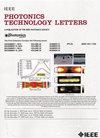High-Resolution Prism/(TiO2/SiO2)3/MoSe2 Bloch Surface Wave Biosensor Based on Bragg Structure
IF 2.3
3区 工程技术
Q2 ENGINEERING, ELECTRICAL & ELECTRONIC
引用次数: 0
Abstract
A dielectric Bragg structure is utilized based on a one-dimensional photonic crystal of alternating TiO2/SiO2 layers as a sensor. MoSe2 termination layer is exploited to excite a Bloch surface wave (BSW) at its interface with the analyte. The light source excites the biosensor through a MgF2 prism at a wavelength of 1100 nm. The proposed biosensor operates based on the variation of the resonance angle due to changes in the refractive index of the biological material, i.e. from 1.33 to 1.34. For ten MoSe2 monolayers, the detection sensitivity is obtained as 287 (°/RIU) with a linear regression coefficient of 0.9953. Correspondingly, the maximum and average values of the figure of merit (FoM) amount to 7316 and 6913(1/RIU), respectively. By decreasing the number of monolayers, the linearity improves and the FoM increases remarkably at the cost of a reduction in the average sensitivity. Such large FoMs provide ultra-high resolutions to distinguish between analytes with very close refractive indices. This is useful in detecting slight changes in the cell concentrations within a host medium. No grating is used in the proposed sensor, which simplifies the fabrication process.基于Bragg结构的高分辨率Prism/(TiO2/SiO2)3/MoSe2 Bloch表面波生物传感器
利用二氧化钛/二氧化硅交替层的一维光子晶体作为传感器的介电布拉格结构。利用MoSe2终端层在其与分析物的界面激发布洛赫表面波(BSW)。光源通过MgF2棱镜在1100nm波长处激发生物传感器。所提出的生物传感器基于由于生物材料折射率的变化而引起的共振角的变化来工作,即从1.33到1.34。对于10个MoSe2单层,检测灵敏度为287(°/RIU),线性回归系数为0.9953。相应的,优值(FoM)最大值为7316,平均值为6913(1/RIU)。通过减少单分子层的数量,线性得到改善,FoM显著增加,但代价是平均灵敏度降低。如此大的FoMs提供超高分辨率,以区分具有非常接近的折射率的分析物。这对于检测宿主培养基中细胞浓度的细微变化是有用的。该传感器不使用光栅,简化了制作过程。
本文章由计算机程序翻译,如有差异,请以英文原文为准。
求助全文
约1分钟内获得全文
求助全文
来源期刊

IEEE Photonics Technology Letters
工程技术-工程:电子与电气
CiteScore
5.00
自引率
3.80%
发文量
404
审稿时长
2.0 months
期刊介绍:
IEEE Photonics Technology Letters addresses all aspects of the IEEE Photonics Society Constitutional Field of Interest with emphasis on photonic/lightwave components and applications, laser physics and systems and laser/electro-optics technology. Examples of subject areas for the above areas of concentration are integrated optic and optoelectronic devices, high-power laser arrays (e.g. diode, CO2), free electron lasers, solid, state lasers, laser materials'' interactions and femtosecond laser techniques. The letters journal publishes engineering, applied physics and physics oriented papers. Emphasis is on rapid publication of timely manuscripts. A goal is to provide a focal point of quality engineering-oriented papers in the electro-optics field not found in other rapid-publication journals.
 求助内容:
求助内容: 应助结果提醒方式:
应助结果提醒方式:


